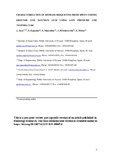Mostrar el registro sencillo del ítem
Characterization of biomass briquettes from spent coffee grounds and xanthan gum using low pressure and temperature
| dc.creator | Seco Meneses, Andrés | es_ES |
| dc.creator | Espuelas Zuazu, Sandra | es_ES |
| dc.creator | Marcelino Sádaba, Sara | es_ES |
| dc.creator | Echeverría, Angel María | es_ES |
| dc.creator | Prieto Cobo, Eduardo | es_ES |
| dc.date.accessioned | 2020-06-05T10:28:32Z | |
| dc.date.available | 2020-11-22T00:00:12Z | |
| dc.date.issued | 2020 | |
| dc.identifier.issn | 1939-1234 | |
| dc.identifier.uri | https://hdl.handle.net/2454/37090 | |
| dc.description.abstract | This paper analyzes the ability of the SCG for briquettes production based on the use of xanthan gum as binder under low-pressure and low-temperature biomass manufacturing conditions. Briquettes were manufactured at room temperature, at 10, 15, 20, 25, and 30% of moisture content and 8, 10, and 12 MPa of compaction pressure. Raw SCG samples reached dry densities between 0.669 and 0.735 g/cm3 for the samples with a moisture content of 15% and 8 MPa and 10% and 12 MPa, respectively. Samples treated with 10% of xanthan gum got densities between 0.672 and 0.819 g/cm3 depending on the moisture content and the compaction pressure. No one of the raw SCG combinations passed the durability test meanwhile xanthan ones with 30% of moisture content obtained the best results with a loss of mass of 9.1% for the combination compacted at 10 MPa. Raw SCG samples showed water absorption values between 0.498% and 0.846%, meanwhile xanthan samples water absorption oscillated between 0.427% and 1.065%. Xanthan gum increased the SCG ashes content from 0.66% to 0.97% and decreased the lower heating value (LHV) from 25,399 J/g of the pure raw SCG to 23,503 J/g. Thermogravimetric tests showed that xanthan gum mix compared to the raw SCG increased as well the volatile peak from 61.54 mW to 81.94 mW as the mass loss rate in the volatile stage from −0.0178 mg/s to −0.0184 mg/s. | en |
| dc.description.sponsorship | This work was funded by Gobierno de Navarra and Fondo Europeo de Desarrollo Regional (FEDER) by the 'Biomasa de marro de café para calderas ecológicas' (Reference: 0011-1365-2016-000070), research project. | en |
| dc.format.extent | 25 p. | |
| dc.format.mimetype | application/pdf | en |
| dc.language.iso | eng | en |
| dc.publisher | Springer | en |
| dc.relation.ispartof | Bioenergy Research, 2020, 13, 369-377 | en |
| dc.rights | © Springer Science+Business Media, LLC, part of Springer Nature 2019 | en |
| dc.subject | Spent coffee grounds | en |
| dc.subject | Fuel | en |
| dc.subject | Biomass | en |
| dc.subject | Briquette | en |
| dc.subject | Xanthan gum | en |
| dc.title | Characterization of biomass briquettes from spent coffee grounds and xanthan gum using low pressure and temperature | en |
| dc.type | info:eu-repo/semantics/article | en |
| dc.type | Artículo / Artikulua | es |
| dc.contributor.department | Ingeniería | es_ES |
| dc.contributor.department | Ingeniaritza | eu |
| dc.contributor.department | Institute of Smart Cities - ISC | es_ES |
| dc.rights.accessRights | info:eu-repo/semantics/openAccess | en |
| dc.rights.accessRights | Acceso abierto / Sarbide irekia | es |
| dc.embargo.terms | 2020-11-22 | |
| dc.identifier.doi | 10.1007/s12155-019-10069-8 | |
| dc.relation.projectID | info:eu-repo/grantAgreement/ES/1PE/MAT2016-78863 | en |
| dc.relation.publisherversion | https://doi.org/10.1007/s12155-019-10069-8 | |
| dc.type.version | info:eu-repo/semantics/acceptedVersion | en |
| dc.type.version | Versión aceptada / Onetsi den bertsioa | es |
| dc.contributor.funder | Gobierno de Navarra / Nafarroako Gobernua | es |


